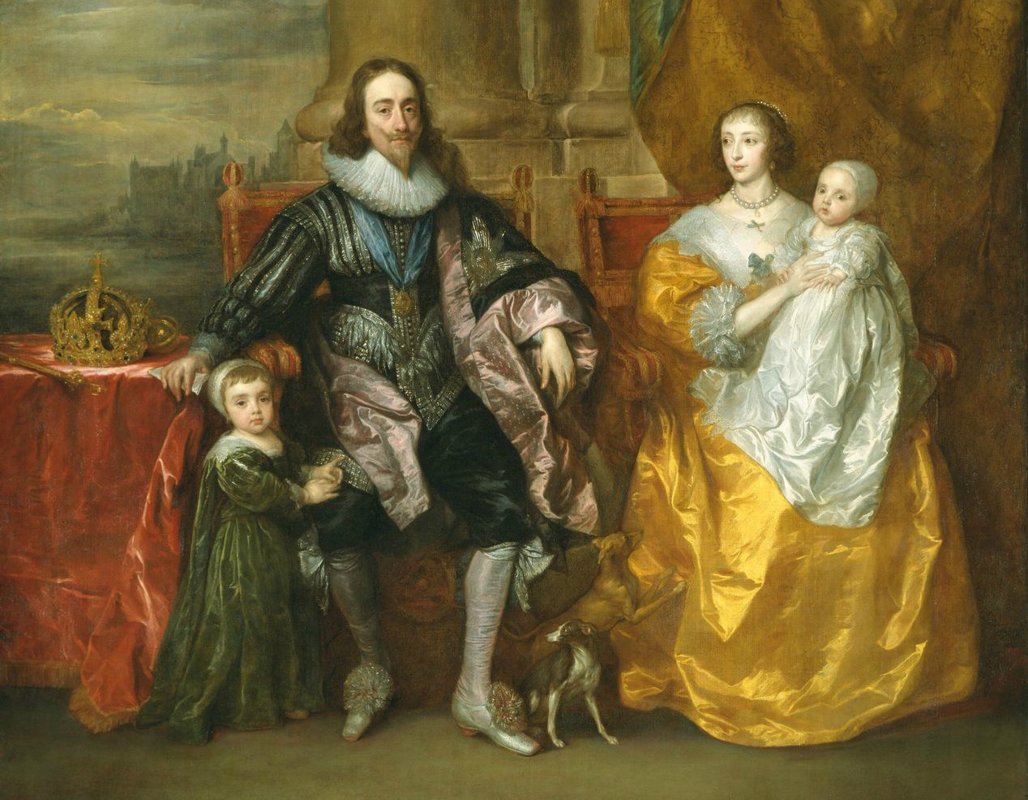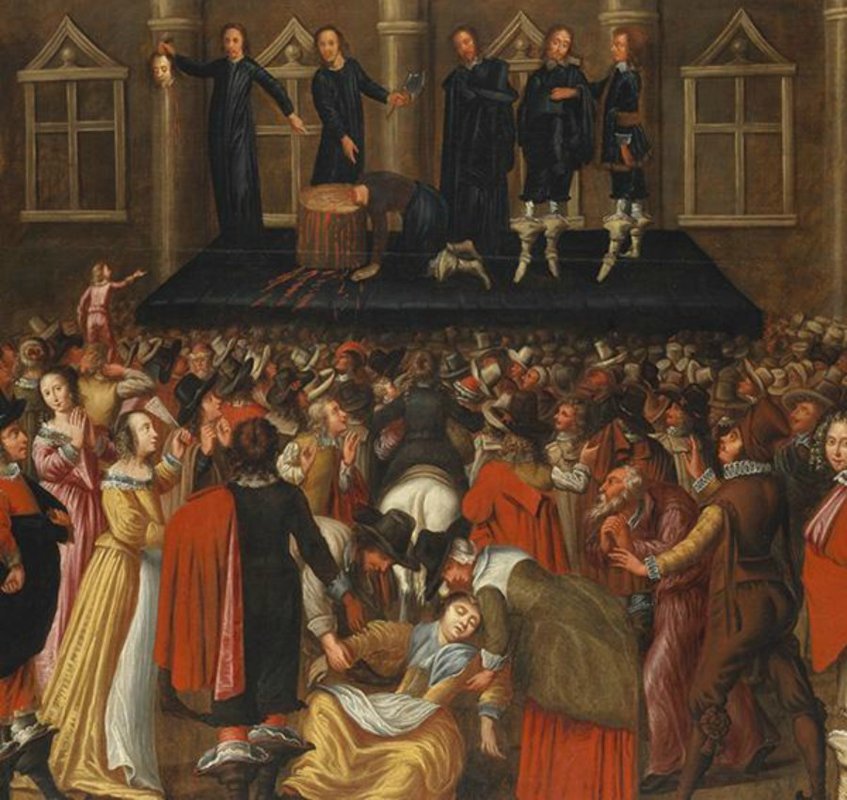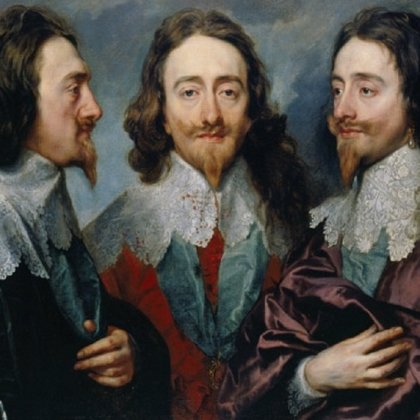THE WAR OF THE THREE KINGDOMS : KING CHARLES I (1600-1649) WAS KING OF ENGLAND,SCOTLAND AND IRELAND,WHOSE CONFLICTS WITH PARLIAMENT LEAD TO CIVIL WAR AND HIS EVENTUAL EXECUTION.
 Charles I (19 November 1600 – 30 January 1649) was monarch of the three kingdoms of England, Scotland, and Ireland from 27 March 1625 until his execution in 1649.Charles was the second son of King James VI of Scotland, but after his father inherited the English throne in 1603, he moved to England, where he spent much of the rest of his life. He became heir apparent to the English, Irish and Scottish thrones on the death of his elder brother, Henry Frederick, Prince of Wales, in 1612. An unsuccessful and unpopular attempt to marry him to a Spanish Habsburg princess culminated in an eight-month visit to Spain in 1623 that demonstrated the futility of the marriage negotiations. Two years later he married the Bourbon princess Henrietta Maria of France instead.
Charles I (19 November 1600 – 30 January 1649) was monarch of the three kingdoms of England, Scotland, and Ireland from 27 March 1625 until his execution in 1649.Charles was the second son of King James VI of Scotland, but after his father inherited the English throne in 1603, he moved to England, where he spent much of the rest of his life. He became heir apparent to the English, Irish and Scottish thrones on the death of his elder brother, Henry Frederick, Prince of Wales, in 1612. An unsuccessful and unpopular attempt to marry him to a Spanish Habsburg princess culminated in an eight-month visit to Spain in 1623 that demonstrated the futility of the marriage negotiations. Two years later he married the Bourbon princess Henrietta Maria of France instead.
Charles I (1600-1649) has gone down in history for losing his head! The second son of James I, he became heir apparent when his older brother Henry died in 1612. In 1625 he king when his father died.Charles believed strongly in the divine right of kings - that God gave him absolute power to rule as he thought fit. Parliament thought otherwise, and were particularly unhappy when Charles insisted on raising taxes without Parliamentary consent. His marriage to Henrietta Maria, a French princess and Roman Catholic, was unpopular with the strict Protestant parliamentarians (Puritans and Calvinists) and many believed that he was a Roman Catholic sympathiser. King and Parliament quarreled often and more aggressively until, in 1624, the two sides went into battle and the English Civil War began.After many battles, Charles I was defeated in 1645 and imprisoned on the Isle of Wight. The other side was led by Oliver Cromwell, who commanded a well-trained "New Model Army" and had firm control of England. Charles was tried and convicted, and - to the dismay of the royal supporters - eventually executed for high treason in January 1649. The monarchy was abolished and the Commonwealth of England was established, led by Oliver Cromwell.King Charles I was apparently very brave as he went to his execution. He said goodbye to his children at St James' Palace and was then escorted to Whitehall, where he uttered these last words:"I go from a corruptible to an incorruptible Crown, where no disturbance can be."Henrietta Maria was the youngest daughter of King Henry IV of France (Henry III of Navarre) and his second wife, Marie de' Medici, and named after her parents. She was born at the Palais du Louvre on 25 November 1609, but some historians give her a birth-date of 26 November. In England, where the Julian calendar was still in use, her date of birth is often recorded as 16 November. Henrietta Maria was brought up as a Catholic. As daughter of the Bourbon king of France, she was a Fille de France and a member of the House of Bourbon. She was the youngest sister of the future King Louis XIII of France. Her father was assassinated on 14 May 1610, when she was less than a year old. As a child, she was raised under the supervision of the royal governess Françoise de Montglat.After her older sister, Christine Marie, married Victor Amadeus I, Duke of Savoy, in 1619, Henriette took the highly prestigious style of Madame Royale; this was used by the most senior royal princess at the French court. Henrietta Maria was trained, along with her sisters, in riding, dancing, and singing, and took part in French court plays.Although tutored in reading and writing, she was not known for her academic skills; the princess was heavily influenced by the Carmelites at French court. By 1622, Henrietta Maria was living in Paris with a household of some 200 staff, and marriage plans were being discussed.
 King Charles I with his wife Henrietta Maria and two of their children.Henrietta Maria of France (25 November 1609 – 10 September 1669) was queen consort of England, Scotland, and Ireland as the wife of King Charles I. She was mother of his two immediate successors, Charles II and James II.
King Charles I with his wife Henrietta Maria and two of their children.Henrietta Maria of France (25 November 1609 – 10 September 1669) was queen consort of England, Scotland, and Ireland as the wife of King Charles I. She was mother of his two immediate successors, Charles II and James II.
The War of Three Kingdoms was a war fought by four sides, but only three nations. It has civil wars and revolutionary wars. It took place from 1638 all the way till 1657. Most of these wars were related to rebellion. It was both a religious and ethnic conflict fought over who would govern Ireland, whether it would be governed from England, which ethnic and religious group would own most of the land and which religion would predominate in the country. The Irish Rebellion of 1641 was intended to be a swift and mainly bloodless seizure of power in Ireland by a small group of conspirators led by Phelim O’Neill. The Bishops' Wars are two conflicts between England and Scotland in 1639-40. They were caused by fierce Scottish reaction against King Charles I's attempt to reform the Scottish church. The King planned to replace the Scottish Presbyterian system of church govenment with the Episcopalian or High Anglican system in order to harmonise the churches of England and Scotland. Furthermore, Charles intended to finance his reforms by re-possessing lands formerly held by the Roman Catholic church in Scotland, which had been sold off at the Reformation. The proposed reforms alienated landowners and noblemen whose holdings were threatened as well as the general Protestant population of Scotland. The Scottish Covenanters sent an army to Ulster in Ireland in 1642 to protect the Scottish settlers there. In 1644, following the signing of a treaty The Solemn League and Covenant with the English Parliament, the bulk of the Covenanters armed forces were sent south to fight on the Parliamentarian side in the English Civil War.The Wars included the Bishops' Wars of 1639 and 1640, the Scottish Civil War of 1644–45; the Irish Rebellion of 1641, Confederate Ireland, 1642–49 and the Cromwellian conquest of Ireland in 1649 (collectively the Eleven years war or Irish Confederate Wars); and the First, Second and Third English Civil Wars of 1642–46, 1648–49 and 1650–51.Although the term is not new and was already used by James Heath in his book A Brief Chronicle of all the Chief Actions so fatally Falling out in the three Kingdoms, first published in 1662, recent publications' tendency to name these linked conflicts the Wars of the Three Kingdoms represents a trend by recent historians aiming to take a unified overview rather than treating some of the conflicts as mere background to the English Civil War. Some, such as Carlton, Gaunt and Royal have labelled them the British Civil Wars, but this can be misleading, because although the three realms were linked by a personal union, the three kingdoms did not become a single political entity until the Act of Union 1800.
The Battle of Naseby was a decisive engagement of the English Civil War, fought on 14 June 1645 between the main Royalist army of King Charles I and the Parliamentarian New Model Army, commanded by Sir Thomas Fairfax and Oliver Cromwell. It was fought near the village of Naseby in Northamptonshire.After the Royalists stormed the Parliamentarian stronghold of Leicester, Fairfax was ordered to lift his siege of Oxford, the Royalist capital, and engage the King's main army. Eager to bring the Royalists to battle, Fairfax set off in pursuit of the Royalist army, which was heading to recover the north. The King, faced with retreating north with Fairfax close behind, or giving battle, decided to give battle, fearing a loss of morale if his army continued retreating. After hard fighting, the Parliamentarian army had all but destroyed the Royalist force, which suffered 6,000 casualties out of 7,400 effectives.Charles lost the bulk of his veteran infantry and officers.
Charles I has gone down in history for losing his head! The second son of James I, he became heir apparent when his older brother Henry died in 1612. In 1625 he king when his father died.Charles believed strongly in the divine right of kings - that God gave him absolute power to rule as he thought fit. Parliament thought otherwise, and were particularly unhappy when Charles insisted on raising taxes without Parliamentary consent. His marriage to Henrietta Maria, a French princess and Roman Catholic, was unpopular with the strict Protestant parliamentarians (Puritans and Calvinists) and many believed that he was a Roman Catholic sympathiser. King and Parliament quarreled often and more aggressively until, in 1624, the two sides went into battle and the English Civil War began.After many battles, Charles I was defeated in 1645 and imprisoned on the Isle of Wight. The other side was led by Oliver Cromwell, who commanded a well-trained "New Model Army" and had firm control of England. Charles was tried and convicted, and - to the dismay of the royal supporters - eventually executed for high treason in January 1649. The monarchy was abolished and the Commonwealth of England was established, led by Oliver Cromwell.King Charles I was apparently very brave as he went to his execution. He said goodbye to his children at St James' Palace and was then escorted to Whitehall, where he uttered these last words:"I go from a corruptible to an incorruptible Crown, where no disturbance can be."Charles' problems revolved around religion and a lack of money. His marriage to the Roman-Catholic French princess Henrietta Maria in 1625 did not please his Protestant subjects and led to suspicions of his motives. In 1637 he totally misgauged the sentiments of his Scottish subjects when he attempted to impose an Anglican form of worship on the predominantly Presbyterian population. Riots escalated to general unrest; forcing Charles to recall Parliament in 1640 in order to acquire the funds necessary to quell the Scottish uprising. This so-called "Short Parliament" refused Charles' financial demands and disbanded after only one month.On 30 January 1649, King Charles I was beheaded outside Banqueting House in Whitehall. The assembled crowd is reported to have groaned as the axe came down. Although the monarchy was later restored in 1660, the execution of Charles I destroyed the idea of an all-powerful and unquestionable monarch.Disagreements between Charles I and Parliament had been simmering for several years. Charles had been exercising too much power, such as raising taxes unreasonably and imprisoning without trial those who did not pay up. Civil war broke out in 1642 and although Charles’s Royalist army had the upper hand at first, his advantage did not last for long. By May 1646, Charles surrendered. Parliament claimed the King ‘had a wicked design totally to subvert the ancient and fundamental laws and liberties of this nation’ and that he had ‘levied and maintained a civil war in the land’. It was decided (after the Royalists had been removed from Parliament and the opinion of the House of Lords ignored) that he would be executed.
 January 30, 1649 was a bitterly cold day. Charles went to his execution wearing two heavy shirts so that he might not shiver in the cold and appear to be afraid. The following account of the event comes from an anonymous observer and begins as the doomed King addresses the crowd from the scaffold:As for the people,truly I desire their liberty and freedom as much as anybody whomsoever; but I must tell you that their liberty and freedom consist in having of government, those laws by which their life and their goods may be most their own. It is not for having share in government, sirs; that is nothing pertaining to them; a subject and a sovereign are clear different things. And therefore until they do that, I mean that you do put the people in that liberty, as I say, certainly they will never enjoy themselves. Sirs, it was for this that now I am come here. If I would have given way to an arbitrary way, for to have all laws changed according to the power of the sword, I needed not to have come here; and therefore I tell you (and I pray God it be not laid to your charge) that I am the martyr of the people. And to the executioner he said, 'I shall say but very short prayers, and when I thrust out my hands.
January 30, 1649 was a bitterly cold day. Charles went to his execution wearing two heavy shirts so that he might not shiver in the cold and appear to be afraid. The following account of the event comes from an anonymous observer and begins as the doomed King addresses the crowd from the scaffold:As for the people,truly I desire their liberty and freedom as much as anybody whomsoever; but I must tell you that their liberty and freedom consist in having of government, those laws by which their life and their goods may be most their own. It is not for having share in government, sirs; that is nothing pertaining to them; a subject and a sovereign are clear different things. And therefore until they do that, I mean that you do put the people in that liberty, as I say, certainly they will never enjoy themselves. Sirs, it was for this that now I am come here. If I would have given way to an arbitrary way, for to have all laws changed according to the power of the sword, I needed not to have come here; and therefore I tell you (and I pray God it be not laid to your charge) that I am the martyr of the people. And to the executioner he said, 'I shall say but very short prayers, and when I thrust out my hands.

